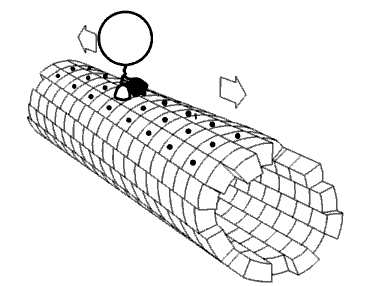
Site‐specific rapid deamidation and isomerization in human lens αA‐crystallin in vitro
Sign Up to like & getrecommendations! Published in 2020 at "Protein Science"
DOI: 10.1002/pro.3821
Abstract: Recent studies have suggested that the isomerization/racemization of aspartate residues in proteins increases in aged tissues. One such residue is Asp151 in lens‐specific αA‐crystallin. Although many isomerization/racemization sites have been reported in various proteins, the… read more here.
Keywords: deamidation isomerization; crystallin; deamidation; isomerization racemization ... See more keywords

A molecular dynamics approach to explore the structural characterization of cataract causing mutation R58H on human γD crystallin
Sign Up to like & getrecommendations! Published in 2018 at "Molecular and Cellular Biochemistry"
DOI: 10.1007/s11010-018-3342-8
Abstract: The crystallins are a family of monomeric proteins present in the mammalian lens and mutations in these proteins cause various forms of cataracts. The aim of our current study is to emphasize the structural characterization… read more here.
Keywords: r58h; molecular dynamics; dynamics approach; crystallin ... See more keywords

RNA aptamers targeted for human αA-crystallin do not bind αB-crystallin, and spare the α-crystallin domain.
Sign Up to like & getrecommendations! Published in 2017 at "Biochemical and biophysical research communications"
DOI: 10.1016/j.bbrc.2017.07.085
Abstract: The molecular chaperones, α-crystallins, belong to the small heat shock protein (sHSP) family and prevent the aggregation and insolubilization of client proteins. Studies in vivo have shown that the chaperone activity of the α-crystallins is raised… read more here.
Keywords: bind; rna aptamers; aptamers targeted; crystallin ... See more keywords

Structural and functional characterization of a missense mutant of human γS-crystallin associated with dominant infantile cataracts.
Sign Up to like & getrecommendations! Published in 2018 at "Biochemical and biophysical research communications"
DOI: 10.1016/j.bbrc.2018.10.187
Abstract: Infantile cataracts constitute one of the most important causes of childhood blindness worldwide. Human γS-crystallin is the most abundant protein in the eye lens cortex. A missense mutant of human γS-crystallin, Y67N (abbreviated hereafter as… read more here.
Keywords: infantile cataracts; missense mutant; mutant human; structural functional ... See more keywords

ATP antagonizes the crowding-induced destabilization of the human eye-lens protein γS-crystallin.
Sign Up to like & getrecommendations! Published in 2020 at "Biochemical and biophysical research communications"
DOI: 10.1016/j.bbrc.2020.04.014
Abstract: In lens, αβγ-crystallins accounting for ∼90% of ocular proteins with concentrations >400 mg/ml need to remain soluble for the whole life-span and their aggregation can lead to cataract. Mysteriously, despite being a metabolically-quiescent organ, lens maintains… read more here.
Keywords: aggregation; crowding induced; crystallin; eye ... See more keywords

Creatine kinase/α-crystallin interaction functions in cataract development
Sign Up to like & getrecommendations! Published in 2020 at "Biochemistry and Biophysics Reports"
DOI: 10.1016/j.bbrep.2020.100748
Abstract: Creatine kinase (CK) is an energy storage enzyme that plays an important role in energy metabolism. CK/phosphocreatine functions as an energy buffer and links ATP production sites with ATP utilization sites. Several key mutations in… read more here.
Keywords: interaction; interaction crystallin; cataract development; creatine kinase ... See more keywords

A Combined NMR and SAXS Analysis of the Partially Folded Cataract-Associated V75D γD-Crystallin.
Sign Up to like & getrecommendations! Published in 2017 at "Biophysical journal"
DOI: 10.1016/j.bpj.2017.02.010
Abstract: A cataract is a pathological condition characterized by the clouding of the normally clear eye lens brought about by deposition of crystallin proteins in the lens fiber cells. These protein aggregates reduce visual acuity by… read more here.
Keywords: partially folded; saxs analysis; cataract; crystallin ... See more keywords

The absence of SIRT3 and SIRT5 promotes the acetylation of lens proteins and improves the chaperone activity of &agr;‐crystallin in mouse lenses
Sign Up to like & getrecommendations! Published in 2019 at "Experimental Eye Research"
DOI: 10.1016/j.exer.2019.02.024
Abstract: Abstract Acetylation of lysine residues occurs in lens proteins. Previous studies have shown an improvement in the chaperone activity of &agr;A‐crystallin upon acetylation. Sirtuins are NAD+‐dependent enzymes that can deacylate proteins. The roles of sirtuins… read more here.
Keywords: agr crystallin; mouse lenses; acetylation; sirt3 sirt5 ... See more keywords

Effect of cataract-associated mutations in the N-terminal domain of αB-crystallin (HspB5).
Sign Up to like & getrecommendations! Published in 2020 at "Experimental eye research"
DOI: 10.1016/j.exer.2020.108091
Abstract: Physico-chemical properties of three cataract-associated missense mutants of αB-crystallin (HspB5) (R11H, P20S, R56W) were analyzed. The oligomers formed by the R11H mutant were smaller, whereas the oligomers of the P20S and R56W mutants were larger… read more here.
Keywords: crystallin hspb5; cataract associated; hspb5; crystallin ... See more keywords

A novel MAF missense mutation leads to congenital nuclear cataract by impacting the transactivation of crystallin and noncrystallin genes.
Sign Up to like & getrecommendations! Published in 2019 at "Gene"
DOI: 10.1016/j.gene.2019.01.011
Abstract: The transcription factor v-maf avain musculoaponeurotic fibrosarcoma oncogene homolog (MAF) plays an important role in lens development. It contains a unique extended homology region (EHR) in the DNA binding domain. MAF mutations are associated with… read more here.
Keywords: transactivation; maf; cataract; congenital nuclear ... See more keywords

Inhibition of amyloid fibrillation of γD-crystallin model peptide by the cochineal Carmine.
Sign Up to like & getrecommendations! Published in 2020 at "International journal of biological macromolecules"
DOI: 10.1016/j.ijbiomac.2020.12.106
Abstract: γD-crystallin is among the most abundant γ-crystallins in the human eye lens which are essential for preserving its transparency. Aging, and environmental changes, cause crystallins to lose their native soluble structure and aggregate, resulting in… read more here.
Keywords: amyloid fibrillation; inhibition amyloid; model; cochineal carmine ... See more keywords